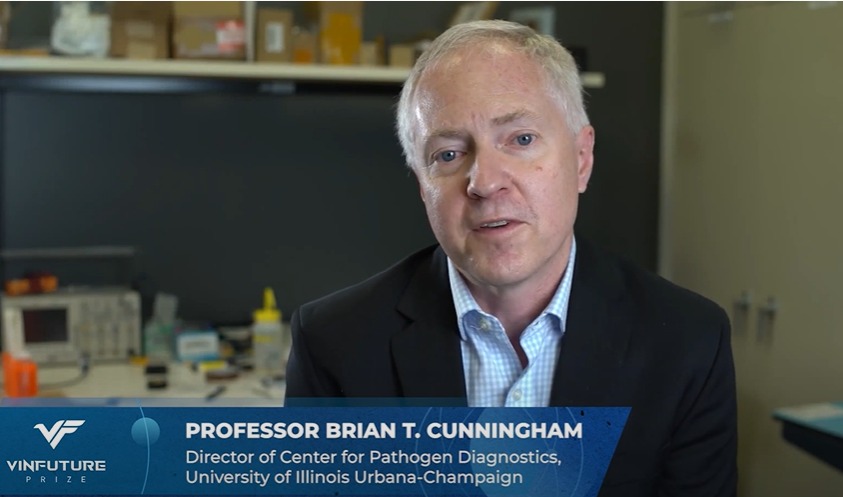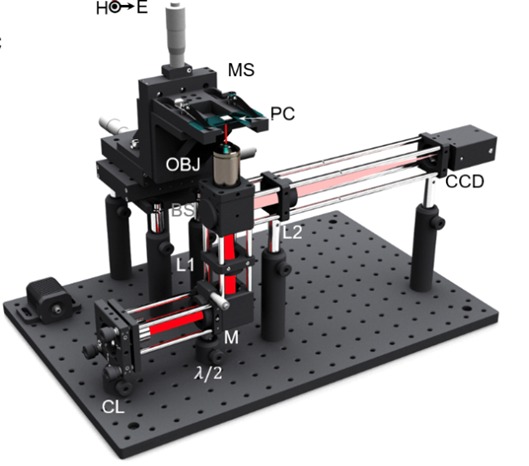Cancer remains one of humankind’s biggest healthcare threats in the 21st century. According to scientists, cancer will soon overtake cardiovascular diseases to become the leading cause of death, but precision medicine stands to solve this problem by providing early diagnosis for cancer patients, helping minimize fatalities.

Precision Medicine in Oncology and the development of inexpensive cancer diagnosis
The quick, accessible, low-cost, and precise cancer detection innovation was the main focus of the second InnovaTalk by VinFuture, with the topic “Cancer measurement at the Point of Care”. The webinar was joined by more than 300 participants from different continents. The ultrasensitive and fast liquid biopsy technology, revealed by Prof. Brian T. Cunningham from University of Illinois Urbana-Champaign (UIUC), USA, at the VinFuture InnovaTalk #2 last July, is expected to launch a new era in early cancer diagnosis.
Because many patients do not respond to the latest therapies, better diagnosis and better accommodation of drugs tailored to specific patients were determined as the future direction for doctors to be able to cure more types of cancer.
Solid tumor biopsy is currently among the most popular methods of cancer detection. This type of biopsy is done by surgically removing some tissue for cancer testing, which can result in unprecedented risks and painful experiences for patients. However, by analyzing cancer genomes revealed by extensive gene sequencing of patients or tumors at various stages of cancer advancement, Prof. Cunningham and his team developed a new paradigm for molecule-based cancer testing to precisely detect individual biomarkers, which are specific to different stages of different cancer types.
Specifically, the biomarkers used are miRNA, ctRNA, and ctDNA, among other types of DNA, RNA and proteins. The biomarkers are released through apoptosis and necrosis from dying cells, or are actively released from viable tumor cells in human blood. The basic principle of liquid biopsy technology is that by measuring the biomarkers from a droplet of blood drawn from the finger or the vein, doctors can spot mutations which are linked to the particular situation as well as the development of the tumors. More importantly, these mutated molecules can be identified even when patients have not yet shown any symptoms.
According to Prof. Cunningham, following the direction of a simple, rapid, and inexpensive assay that can be frequently performed to enable early detection, treatment planning, effectiveness measurement, and recurrence monitoring, scientists developed a non-invasive point-of-care device for routine use in clinical settings. The device, which can be used at room temperature, recently highlighted the ability to detect mutated molecules directly out of human serum and quickly give precise results after only one minute with one testing step.
“The basic idea is the molecules could be measured quantitatively, and if they are measured at a very low concentration, you can see the transition from normal physiology to cancer, the development of mutations and how they progress throughout cancer. This information will then be used to guide the treatment and monitor for recurrence.” – said Prof. Cunningham
Potential future directions
“As long as we can save a few lives by doing research, I always say that each life is a world, so we like to save many worlds,” shared Prof. Chi Van Dang – Chair of the second VinFuture InnovaTalk.

Prof. Chi Van Dang is the Scientific Director of the Ludwig Institute for Cancer Research, (USA), and a member of the VinFuture Prize Council, who has spent years researching the development of cancer treatment. He has a great interest in novel and revolutionary technologies, with liquid biopsy as an example, to conquer cancer – the disease that is widely believed to be “incurable” – and actualize the mission to save as many lives as possible.
Answering Prof. Chi Van Dang’s question about the future timeline for this technology, Prof. Cunningham described it as a long road ahead. Starting from a technology that works in the laboratory, the next step is building replicas of the device and sharing them with laboratories in other universities to train them to do the same assay. At the same time, financial resources and research grants need to be raised for clinical studies, together with research collaborations to validate the technology.
Prof. Cunningham said: “Despite its quality and positive results, the technology still needs to be benchmarked against gold standard techniques such as PCR”.
He also shared that various projects will be implemented to gradually expand the technology to different types of cancers, and that the long-term strategy is to talk to investors, get venture capital, find commercialization partners, and form a company.
Sharing about his expectations, Prof. Cunningham said: “The most important challenge is that the cancer measurement needs to be proven, be used, and perform diagnoses on patients.”
The InnovaTalk webinar series was launched by the VinFuture Foundation, including six seminars taking place from the end of June until the end of November 2022. Each seminar will be led by a member of VinFuture’s scientific councils or a VinFuture Prize laureate. Invited guest speakers are leading international scientists from different high-tech fields and distinguished professors from top global universities and research institutes.
Through the webinar series, VinFuture aims to build a platform for more than 2,000 viewers to connect with science, exchange knowledge, and discuss with scientists and scholars about pressing global issues, as well as to portray the meaningful roles and contributions of the Vietnamese scientific community in the global value chain.

